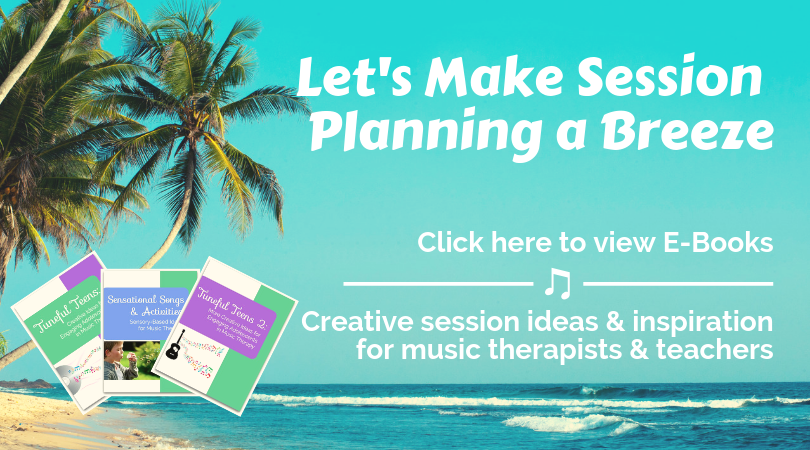
I will be the first to admit that I like to have control of things when it comes to my business and my music therapy sessions. I’m an overachiever in the organization department and I need to have a plan in place for everything.
So, the thought of pulling back on the reins and letting my clients take the lead in our sessions feels a bit… uncomfortable.
But, I am willing to be uncomfortable! As I’ve written about before, as music therapists we ask our clients to do things ALL the time that are out of their comfort zone! We need to be willing to do the same.
What does it look like to let a client take the lead in a session?
In an individual session with a child with autism, it might look like letting that child dig through my big bag of “stuff” (the one with ALL the instruments, books, props and visuals) to choose what they want to do next.
I’ll open the bag in the middle of the room and just let the child explore.
Whatever they pick out tells me a bit about what’s interesting, motivating and engaging for them.
I then use that instrument/item/prop therapeutically to address one of their goals.
As music therapists, we are trained to be flexible and creative in the moment (it’s one of the things I love most about my job). It’s something I had my interns at United Cerebral Palsy practice in the last months of their internship. (I’d choose a variety of random props, instruments and visuals and send them in to facilitate a session using only those items and their creativity).
Engagement is the key to getting our clients to meet their goals.
So, if we can find what things motivate and engage our clients, we can use those things to build rapport, develop the therapeutic relationship and work towards meeting their goals.
Here are a few examples:
Hula hoops: Last week a client grabbed some hula hoops in the sensory gym. He needed to work on impulse control, so we started off by doing a hula hoop stop and go: I instructed him to hula while the music played, then stop when the music stopped. Following that, I laid the three hula hoops out in a row and we jumped “in and out” of each hula hoop to the rhythmic beat of the music.
Animal cards: Another client I work with was particularly fascinated by a set of jungle animal cards I had in my bag. These cards were intended for another client, and I hadn’t planned on using them that day. However, one of this client’s goals was improving memory and recall. So I came up with a quick “I Wanna Find a Match” song and we played Musical Memory. I laid out all the cards face down, and since there were duplicates of each animal, asked him to turn over a card when he heard a musical cue (the wind chimes) to find a match.
Tubano: I work with a class of 2nd graders with ASD and ADHD who are fascinated by drums. I recently got in a new order of instruments and one that caught their attention immediately was the tubano. So for that session, instead of accompanying myself on guitar or keyboard like usual, I used the tubano as my accompaniment instruments for all the songs. I came up with interesting beats that sounded different for each song, and at the end of the session let each student have an opportunity to play.
These are just a few recent examples of how I’ve tried to follow a client or client’s lead and use what motivates them (rather than what I had planned!) to engage them.



Great reminder! Engagement is key. Thank you for sharing.